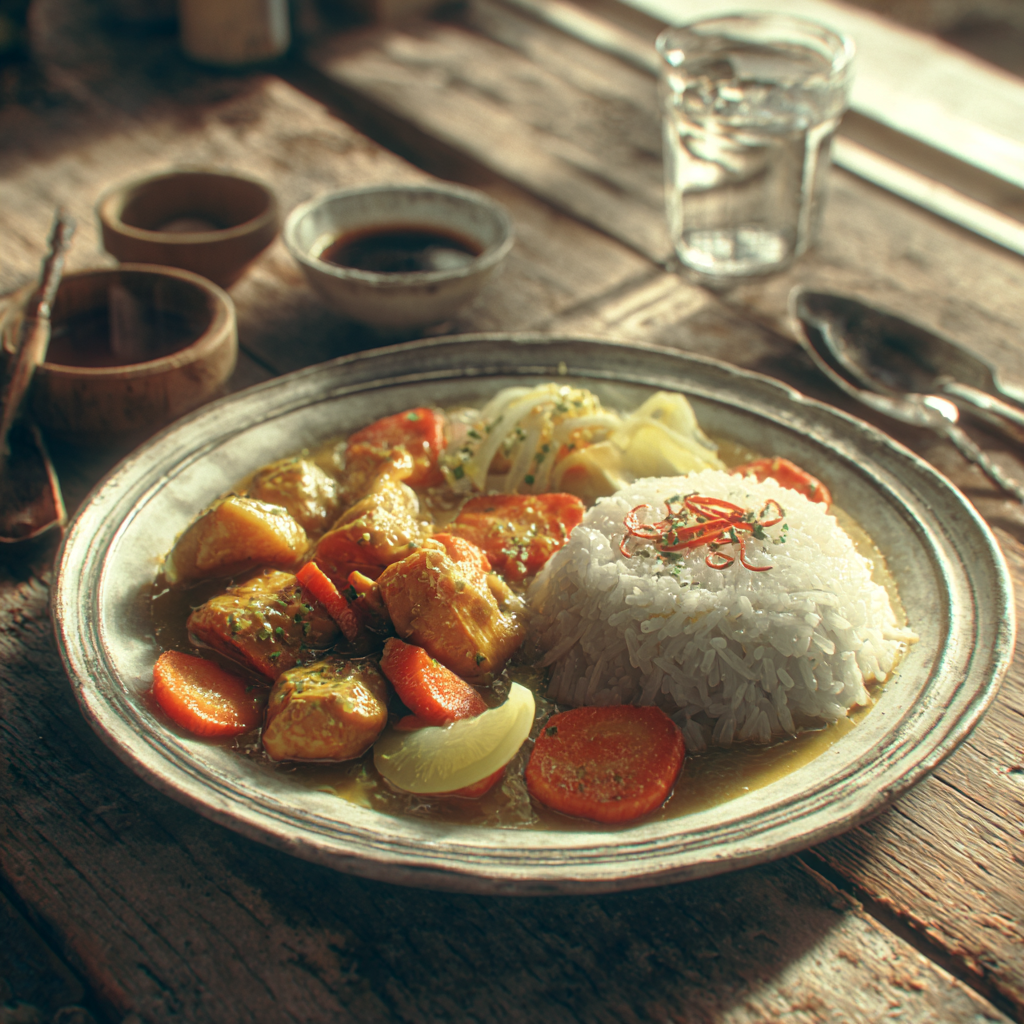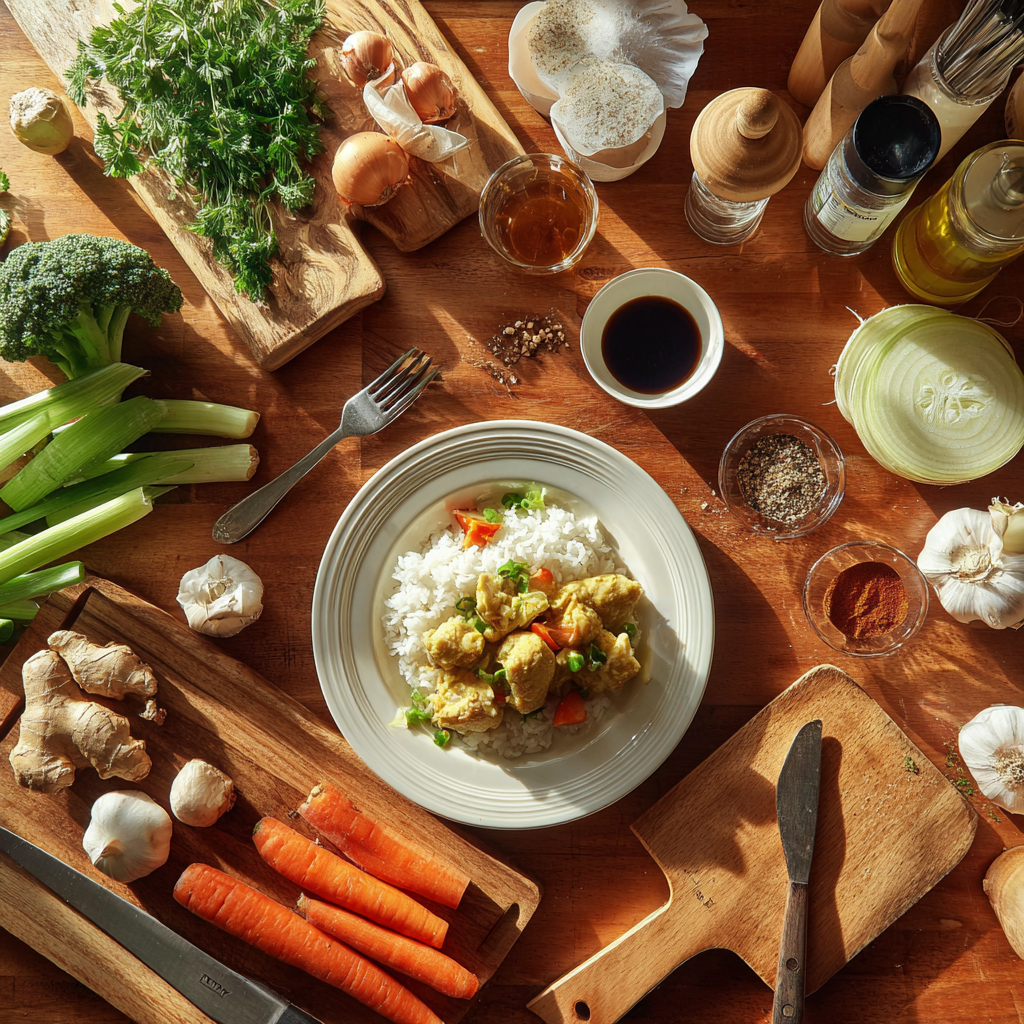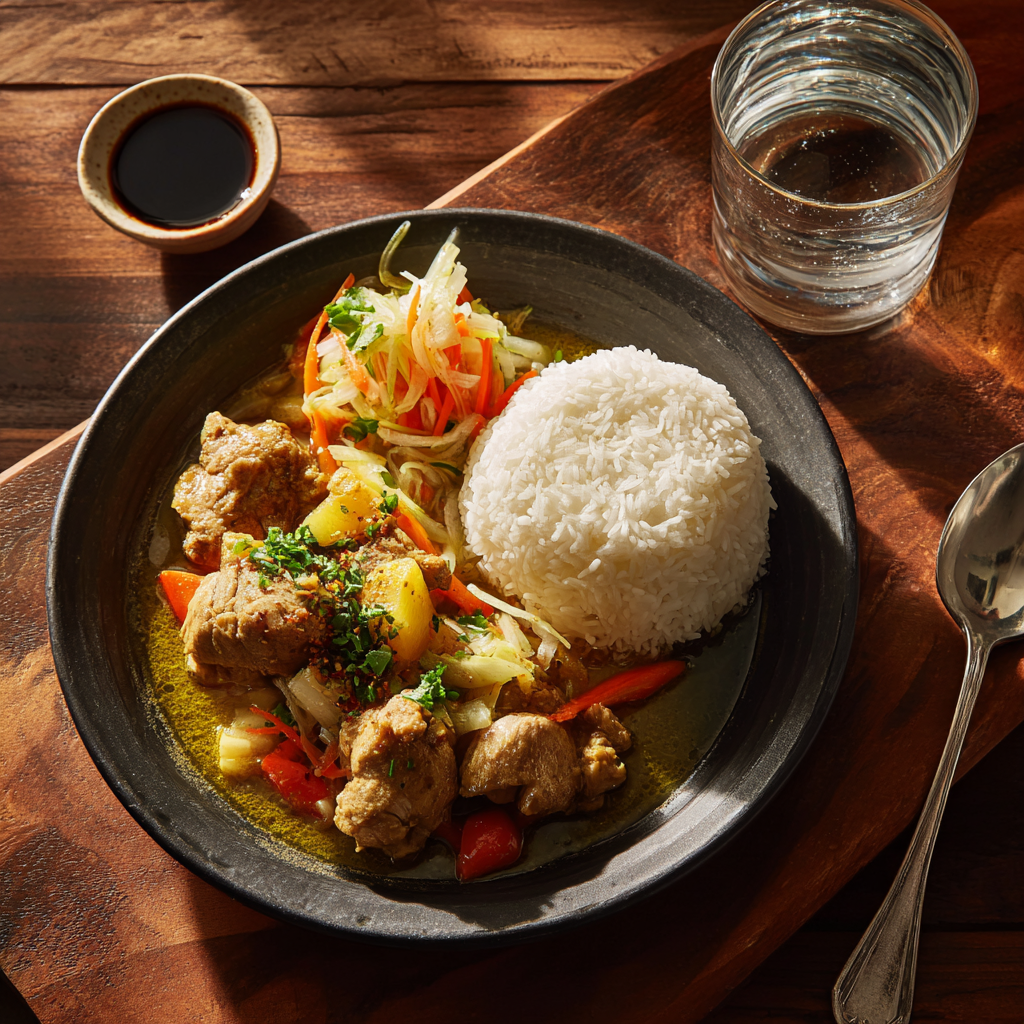
Introduction
I’ve always had a soft spot for discovering new recipes. There’s something magical about turning simple ingredients into a dish that tells a story. One of my all-time favorites is Filipino chicken curry recipe. It’s warm, comforting, and packed with rich spices that feel like a hug in a bowl.
The first time I tried Filipino chicken curry, I was hooked. It felt familiar yet unique—like a cozy blanket with a fresh design. This dish blends bold spices with local flavors, making it stand out from other curries. Whether you’re cooking with coconut milk or trying a version without it, there’s so much to explore. In this article, I’ll share tips, variations, and answers to questions like Why is Filipino curry yellow? Let’s dive in!
What Makes Filipino Curry Unique?
If you’ve ever wondered what sets Filipino chicken recipe apart from others, you’re not alone. Many people compare it to Indian-style curries, but the truth is, they’re quite different. While Indian curries often use garam masala and cream, Filipino curry leans on ingredients like turmeric and evaporated milk. This gives it a distinct flavor profile that’s both creamy and aromatic.
One question I hear often is, Why is Filipino curry yellow? The answer lies in one key ingredient: turmeric. This vibrant spice doesn’t just add color; it also brings earthy notes that balance the dish’s richness. Unlike some curries that rely on heavy cream, Filipino curry uses evaporated milk to create its signature smooth texture. It’s lighter but still deeply satisfying.
Another thing that makes Filipino curry special is how adaptable it is. You can tweak it to suit your taste. For example, some people love adding potatoes for extra heartiness, while others skip coconut milk entirely. Whether you’re following a chicken curry recipe sa tagalog or experimenting with your own twist, the result is always delicious.
Essential Ingredients for Making Chicken Curry
Now let’s talk about the building blocks of a great filipino chicken curry recipe. Having the right ingredients is key to nailing that authentic flavor. Here’s a list of essentials:
- Chicken: Use bone-in pieces for richer flavor.
- Turmeric: Gives the dish its iconic yellow color.
- Onion, garlic, and ginger: These aromatics form the base of the curry.
- Cumin and coriander: Essential spices that add depth.
- Evaporated milk: A creamy alternative to coconut milk.
- Potatoes (optional): Adds texture and makes the dish more filling.
Some folks ask, What is the secret ingredient in curry? Honestly, it’s not just one thing—it’s the combination of spices working together. Cumin adds warmth, while coriander brings a citrusy note. Together, they create layers of flavor that make each bite exciting.
If you’re looking for substitutes, don’t worry! Not everyone has access to every ingredient. For instance, if you want to try filipino chicken curry recipe without coconut milk, evaporated milk works beautifully. Or, if you’re avoiding dairy altogether, you can use vegetable broth instead. The goal is to make the dish your own.
A common mistake when making how to cook chicken curry indian style or Filipino-style is rushing the process. Spices need time to bloom and release their full potential. Always sauté them gently before adding liquids. Another tip? Don’t skimp on the onion base. Cooking it until golden brown builds a strong foundation for the entire dish.
Whether you’re aiming for a special chicken curry or keeping it simple, these small details matter. With the right techniques and ingredients, you’ll have a dish that’s bursting with flavor and character.

Step-by-Step Instructions to Cook Filipino Chicken Curry
Alright, let’s get down to business. Now that we’ve covered the essentials and ingredients, it’s time to roll up our sleeves and dive into the cooking process. Whether you’re a beginner or someone who’s been in the kitchen for years, I’ll walk you through paano magluto ng chicken curry step-by-step. By the way, if you’re curious about how this dish compares to something like an instant pot rotisserie chicken recipe, just know they’re worlds apart—both delicious but totally different vibes.
Let’s break it down. First, you’ll want to prep your chicken. Grab those bone-in pieces because they add more flavor as they simmer. Toss them with some turmeric, salt, and pepper. Let them sit while you get everything else ready. Funny enough, marinating is one of those steps people skip, but trust me—it makes all the difference.
Sautéing the Base
Heat a bit of oil in a large pan or pot over medium heat. Throw in chopped onions, garlic, and ginger. This trio is practically the holy trinity of Filipino cooking. Sauté until the onions turn golden brown. Here’s the thing: don’t rush this part. Cooking the base slowly allows the flavors to develop fully. If you’ve ever wondered why your curries taste flat, it might be because you didn’t give the aromatics enough love.
Once the onions are soft and fragrant, sprinkle in your spices—cumin, coriander, and a pinch of turmeric for extra color. Stir everything together for a minute or two until the spices become aromatic. You’ll know it’s ready when your kitchen smells incredible.
Simmering the Curry
Now comes the fun part. Add the chicken pieces to the pot and let them sear slightly on all sides. This locks in the juices and gives the meat a nice texture. After a few minutes, pour in water (or broth if you’re feeling fancy) until the chicken is mostly submerged. Lower the heat, cover the pot, and let it simmer gently.
Funny story—I once forgot to lower the heat, and my curry turned into a sad, dry mess. Lesson learned: patience is key. Let it cook for about 20-30 minutes, or until the chicken is tender. While it simmers, you can chop up potatoes if you’re using them. They add a hearty touch and soak up all that flavorful sauce.
Variations: Coconut Milk vs. Evaporated Milk
Here’s where things get interesting. If you’re going for a classic chicken curry with coconut milk, stir in a can of coconut milk during the last 10 minutes of cooking. It adds richness and a tropical vibe that pairs beautifully with the spices. On the flip side, if you’re making a filipino chicken curry recipe without coconut milk, swap it out for evaporated milk instead. Honestly, both versions are amazing—it just depends on what you’re craving.
Oh, and here’s a tip: if you’re looking to switch things up, try adding veggies like carrots or bell peppers. They blend seamlessly into the dish and make it even more filling. For inspiration, check out this kosher chicken breast recipes article, which has some great ideas for incorporating vegetables.
Serving Your Masterpiece
When the chicken is fall-off-the-bone tender and the sauce has thickened slightly, it’s time to serve. Ladle the curry over steamed rice, and garnish with fresh cilantro or green onions if you have them. Personally, I think serving it family-style brings everyone closer together—it’s kind of like sharing a big warm hug.
Tips for Perfecting Your Dish
Okay, real talk. Even though I’ve shared the basics, there are a few pitfalls to watch out for. One common mistake people make is dumping all the liquids at once without letting the spices bloom first. That’s a no-go. Always sauté your spices before adding anything wet. Speaking of mistakes, overcooking the chicken is another issue. Keep an eye on it, especially if you’re using boneless cuts. Nobody likes rubbery chicken!
Balancing the spices can also trip people up. Start small, then adjust as you go. Taste frequently, and don’t hesitate to tweak the seasoning. Sometimes a squeeze of lime juice or a dash of sugar can brighten the whole dish. And hey, if you accidentally go heavy-handed with the turmeric, don’t panic—it won’t ruin the meal, promise.
Consistency matters too. Some folks prefer their curry thick and creamy, while others like it soupier. If yours is too thin, let it simmer uncovered for a bit longer. Too thick? Add a splash of water or broth. Easy peasy.
Exploring Special Variations of Chicken Curry
Ready to take your special chicken curry game to the next level? The beauty of this dish lies in its versatility. Want to amp up the protein? Try throwing in some shrimp or tofu alongside the chicken. Or, if you’re a fan of bold flavors, experiment with adding curry leaves or lemongrass for an extra layer of complexity.
I recently made a version inspired by a cheez it chicken breast recipe. Instead of cheese crackers, I sprinkled crushed nuts on top for crunch. Sounds random, but wow—it worked wonders! Don’t be afraid to get creative. Maybe toss in some spinach or kale near the end for a pop of green. Just remember to stay true to the core technique.
By the way, if you’re hunting for the chicken curry best recipe, consider tweaking it based on your mood or pantry staples. No potatoes? Use sweet potatoes. Out of evaporated milk? Go for cream or yogurt. There’s no right or wrong way, really. Food should reflect who you are.
To wrap this section up loosely, I’ll leave you with a little nugget of wisdom. Cooking isn’t about perfection—it’s about connection. Whether you’re whipping up a comforting bowl of chicken curry recipe sa tagalog or riffing on something entirely new, enjoy the process. Oh, and if you’re ever in need of comfort food inspo, this stouffer’s grandma’s chicken and rice bake recipe might spark some ideas.

Serving Suggestions and Pairings for Your Filipino Chicken Curry
Alright, let’s talk about how to serve this dish because, honestly, presentation and pairings can elevate your filipino chicken curry recipe from good to unforgettable. Steamed rice is the ultimate classic side—it’s like peanut butter and jelly, you just can’t separate the two. But here’s a twist: try using jasmine rice instead of plain white rice. That subtle floral aroma? Game changer.
Now, if you’re feeling adventurous, whip up some pandesal. These soft, pillowy rolls are a staple in Filipino households, and they’re perfect for soaking up every last drop of that creamy sauce. Funny enough, I once served my curry with garlic bread at a family dinner, and it was surprisingly awesome. You could say it’s fusion at its finest.
For a refreshing contrast, pickled vegetables are a must-try. Think green papaya or carrots marinated in vinegar and spices. They cut through the richness of the curry and add a tangy crunch that’s just delightful. By the way, if you’ve never tried making atchara (Filipino-style pickled veggies), now’s the time. It’s ridiculously easy and pairs beautifully with almost any savory dish.
Here’s the thing: Filipino chicken curry isn’t just for weeknight dinners. It shines during special occasions too. Picture this—family gatherings where everyone brings their signature dish, and you walk in with a steaming pot of curry. Suddenly, you’re the star of the party. Why? Because this dish isn’t just food; it’s comfort in a bowl. One bite, and people start reminiscing about childhood meals or Sunday lunches at lola’s house.
And guess what? This chicken curry best recipe works for breakfast, lunch, OR dinner. Yes, breakfast. Serve leftovers with a fried egg on top, and boom—you’ve got yourself a hearty morning meal. Trust me, once you go curry-for-breakfast, there’s no turning back.
FAQ Section: Everything You Need Once Answered
Q: What makes Filipino curry different?
Filipino curry stands out because it blends local flavors with milder spice levels compared to Indian or Thai curries. Instead of heavy cream or coconut milk dominating the dish, evaporated milk often takes center stage, giving it a lighter yet creamy texture. Plus, ingredients like turmeric give it that signature yellow hue while keeping things approachable for those who aren’t fans of fiery heat.
Q: What is the secret ingredient in curry?
If I had to pick one, it’d be turmeric—not only for its vibrant color but also for its earthy undertones. However, the real magic happens when all the spices come together. Cumin adds warmth, coriander brings brightness, and turmeric ties it all together. Oh, and don’t forget the evaporated milk for that silky finish. Honestly, it’s less about one “secret” ingredient and more about balance.
Q: What are some common mistakes to avoid when making chicken curry?
Rushing the process is probably the biggest culprit. Spices need time to bloom, so sauté them properly before adding liquids. Another mistake? Overcooking the chicken until it’s dry and rubbery. Keep an eye on it, especially if you’re using boneless cuts. Lastly, taste as you go. Adjusting seasoning mid-cook ensures everything turns out perfectly balanced by the time you serve.
Q: Why is Filipino curry yellow?
Turmeric is the star here—it not only gives the curry its iconic golden color but also infuses it with a warm, slightly peppery flavor. In Filipino cuisine, turmeric has cultural significance too, often used in traditional dishes for both its health benefits and vibrant appearance. So yeah, it’s not just aesthetics; it’s rooted in heritage.
Q: Can I make Filipino chicken curry without coconut milk?
Absolutely! Many recipes swap coconut milk for evaporated milk, which keeps the dish creamy without the tropical notes. Personally, I love both versions depending on my mood. If you’re aiming for something lighter, evaporated milk is your best bet. Just remember to adjust the seasoning since each liquid brings its own flavor profile.
Q: How do I store leftovers?
Leftovers are amazing—they actually taste better the next day as the flavors meld together. Store them in an airtight container in the fridge for up to three days. Reheat gently on the stovetop or microwave, adding a splash of water or broth if the sauce thickens too much. Pro tip: freeze portions for quick meals later!
Q: What vegetables go well in chicken curry?
Potatoes are a classic choice, but feel free to get creative. Carrots, bell peppers, and even sweet potatoes work wonders. For greens, toss in spinach or kale towards the end of cooking. They wilt quickly and add a pop of color and nutrients. Honestly, whatever you have in your crisper drawer will probably work.
Q: Is Filipino chicken curry spicy?
Not typically, no. Unlike some curries that pack serious heat, Filipino chicken curry leans more on warmth than spiciness. That said, you can always amp it up with chili flakes or fresh chilies if you prefer a kick. Or stick to the original mild version—it’s still packed with flavor.
Q: Can I use boneless chicken?
Of course! While bone-in pieces add depth, boneless chicken cooks faster and is equally delicious. Just be careful not to overcook it, as it tends to dry out quicker. Cut it into chunks for even cooking, and consider browning it briefly before simmering to lock in juices.
Q: Where can I find authentic Filipino curry recipes?
Check out local cookbooks or online resources dedicated to Filipino cuisine. Websites like Chicken Recipes offer tons of inspiration for dishes beyond paraan at sangkap sa pagluluto ng chicken curry. Better yet, ask a Filipino friend or neighbor—they might share their lola’s secret recipe!
Final Thoughts and Encouragement
Cooking should be fun, not stressful. Whether you’re following a traditional chicken curry recipe sa tagalog or putting your spin on it, the most important thing is to enjoy the process. Food connects us—to our families, our roots, and even strangers across the table sharing a laugh over seconds (or thirds).
I’d love to hear how your curry turns out! Did you stick to the script, or did you throw in some wildcards? Share your stories in the comments below—I promise I’ll respond. And hey, don’t be shy about asking questions either. We’re all learning together.
So grab your apron, crank up some music, and dive into creating your own masterpiece. After all, life’s too short for boring meals. Let’s make magic happen, one bowl of special chicken curry at a time!

Filipino Chicken Curry Recipe
Equipment
Nutrition
Notes
Adjust spices according to your preference, and don’t hesitate to add vegetables like carrots or bell peppers.
Leftovers taste better the next day; store them in an airtight container in the fridge.
You can serve this curry with jasmine rice or even pandesal for a delightful experience.
Try adding leftovers for breakfast topped with a fried egg for a hearty meal!
